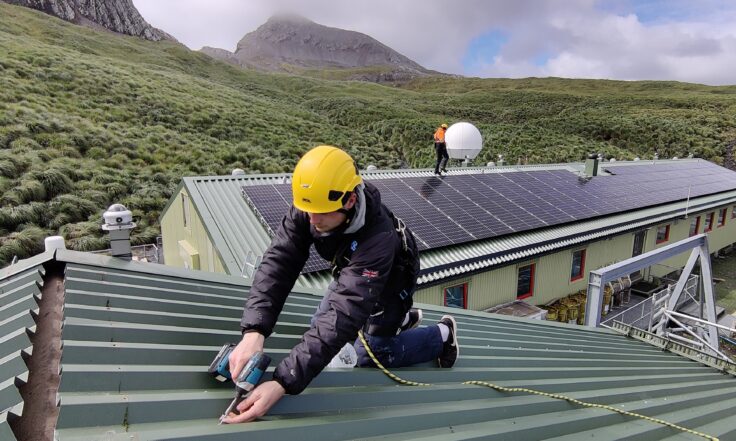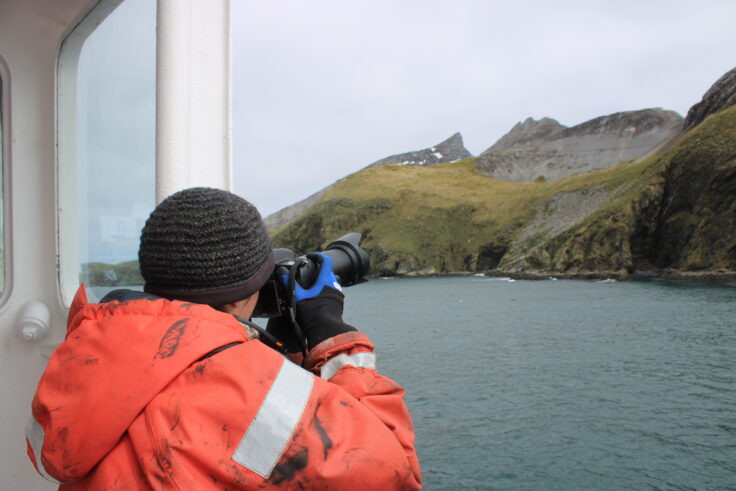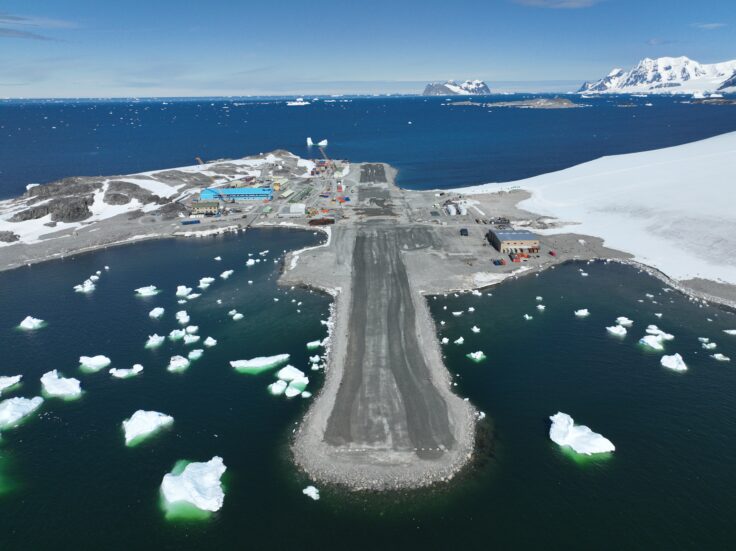Keeping up with our fast changing world is tough – whether that’s social change, technological change, or climate change. As we work to plan the next 10 years at British Antarctic Survey, how can our priorities deliver for polar science and policymakers?
This month’s Beyond the Ice insights come from Amie Jackson, our Head of Strategy and Transformation. She digs into the priorities shaping our strategy for the next 10 years, the interconnected changes coming from technology, engineering and infrastructure, and how polar science is already adapting for the future
This February marked 80 years since Operation Tabarin established the UK’s research presence in Antarctica in 1944, and the early beginnings of British Antarctic Survey. Of course, since then, the UK’s contribution to polar research has developed, grown, and taken different forms depending on the demands of science and wider society.
What hasn’t changed is the deep relevance of the polar regions to all of us, no matter where we live. Over those 80 years planet has been changing, at a rate faster than anticipated – and polar science is at the forefront of understanding of climate change and adapting to a changing world.
In this article, I wanted to share how we’re approaching change in the next 10 years, as we adapt to meet our changing world. British Antarctic Survey looks after all of the UK’s infrastructure polar infrastructure, so our planning is crucial to meeting the needs of our science community and the insights we can offer decision-makers about our planet.
Changing with the times
Whist many of the things we do at British Antarctic Survey will be the same in 2033, the way in which we deliver them will almost certainly look very different.
As part of the process of creating our strategy for the next 10 years, we came up with nine key themes where we know we want and need to drive change. However, there are four that key priorities that weave through our plan as a whole – priorities which reflect the social and knowledge shifts we’re seeing around the world and that we want to embrace for polar science.
What are these priorities? Digital innovation and technology, embracing the rapid shifts in computing and AI, automation and engineering; environmental sustainability, innovating to make progress on our target to reach Net Zero by 2040; modernisation, by which we mean ensuring our physical and communications infrastructure can support polar science into the future; and safety culture, supporting resilience and best practice for our teams across physical, mental and social safety.
Digital innovation and technology
Digital and technology are fast becoming our main areas of development at British Antarctic Survey. If you’ve been keeping an eye on our news stories you’ll already see this in evidence – for instance, last month we began testing of the Windracers ULTRA UAV drone at Rothera Research Station.
Over the next decade, we’ll be working to integrate our many different areas of digital – from artificial intelligence, geospatial, and autonomous vehicle use, to business systems, and the hardware and software of our digital estates.
Ensuring our systems are compatible and aligned with internal and external partners is a key theme, both for efficiency and resilience and whilst we will continue to develop new digital solutions, we will also be working in the background to strengthen our digital foundations that underpin all our digital and technology, and are common across all disciplines, for example, principles around data and information management.
Where these different areas of digital development come together, we can unlock huge progress. For example, successful work from the BAS AI team on accurately predicting sea ice extent is now being developed into a new AI route-planning tool for ships navigating ice-covered polar seas. PolarRoute makes use of a wide variety of existing environmental datasets and forecasts to develop a navigational route planner that updates as conditions change, similar to an in-car navigation system. This will be used by the Master of the UK’s polar research ship, RRS Sir David Attenborough, to compare and evaluate possible routes between destinations in terms of their fuel and carbon costs. This capability could also be deployed for future route planning of marine autonomous vehicles.

A key contributor to the success of our application of digital and technology is development of a culture that is able to trust and understand the importance of embracing innovation – and a workforce with the appropriate skills and expertise to take advantage of developments and be able to act as advocates for digital approaches.
Environmental sustainability
As an environmental science organisation, it is only right that our approach to environmental sustainability takes a position front and centre within our strategy. It is a challenge for us all to cut greenhouse gas emissions and live in better balance with our planet. We have made an ambitious commitment to reach net zero carbon emissions by 2040 in line with our partner’s sustainability strategy and in order to achieve it, carrying out activity in a low carbon way must become second nature.

Some of these changes are already coming from technology change – moving to renewable power where we can, or alternative fuels. My colleagues Parthena (Nopi) Exizidou, Head of Net Zero Transition, and Dr Beatrix Schlarb-Ridley, Director of Innovation & Impact, wrote in-depth about our work on Net Zero in November – you can find that blog here.
Whilst technology will play a large part in delivery of our net zero targets, adaptation of our behaviours and the way that we operate are equally important, and therefore we have a significant cultural challenge ahead of us that will help people make changes to the way they carry out their work, be it science or operations, in order to support our global objectives.
Sustainability is much wider than just Net Zero and the organisational strategy focuses on ensuring we take a balanced view across all sustainability considerations to ensure we are making fully informed decisions that support our values as well as our aspirations. For instance, we think this should also include enhancement of our biosecurity procedures, to ensure we keep Antarctica free of non-native species, and limit our impact on wildlife.

Modernisation
As an organisation, we are focused on looking forward in order to prepare ourselves in the best way possible, and therefore our Antarctic Infrastructure Modernisation Programme (AIMP) is currently helping to ensure we have infrastructure and assets that will support future generations of polar scientists.
An example of this is our new science and operations facility at Rothera, the Discovery Building – which we’re really excited will shortly be complete. This season has been focussing on the internal fit-out of the new building and resurfacing the runway. The runway is an important international gateway for Antarctic science and recent works ensure we can continue to offer aircraft facilities to ferry cargo, scientists and support staff to research stations in the polar regions. As the seasons now shift towards polar winter, for the first time there will be members of the modernisation project team also ‘wintering’ at the station, further pushing forward progress on the fit-out of the Discovery Building.

However, modernisation is not just about physical infrastructure, and our strategy lays out a path to ensure the principles are applied across everything we do. Our communications needs are changing rapidly with the development of digital and autonomous technology, therefore we will be leveraging advancements in internet and bandwidth, along with computing infrastructure for both operations and science to ensure we can get ahead of the curve where possible.
Safety
Operating in one of the world’s most extreme environments means that many of the activities we undertake, such as carrying out fieldwork in Antarctica, has inherent risk. That doesn’t mean we shouldn’t do those things – we just need to ensure that we do everything we can to make them as safe as possible.
However, safety is not just about Antarctica. It’s at the heart of everything we do, whether that is staff working around the world or in the UK, we must ensure that we address those environments with equal attention, acknowledging the different needs of the things we do and areas we operate.
We want to make sure we have the right working conditions and environment to foster a safe culture and build resilience. That means considering our mental health under the same banner as our physical safety to ensure we are looking after all aspects of our people’s wellbeing. Over the next 10 years we will focus on developing the behaviours, process and procedures that ensure what we do is inherently safe. BAS have recently launched our Safety Together campaign which brings mental health and social wellbeing into our safety management system.
What next?
We have now established a direction for where we want to go as an organisation over the next 10 years – which is a critical step for building a cohesive team approach.
Our next step is to start generating a more detailed plan for how we are going to deliver our strategy. As this article hopefully shows, we are not starting from scratch with any of our aspirations for the future. In the coming months and years, we will be pulling together a clear roadmap that defines the timelines, dependencies and routes for how we are going to progress on our journey.
This is a 10 year strategy and we have to be realistic about the time frames in which we are able to deliver the future. In some instances advancements in technology will define our path; in others it will be down to the capacity we have as an organisation, however the key to this whole process is laying down the initial building blocks and establishing an organisation wide common goal for where we fundamentally want to be.
We are at the beginning of our journey and the next 10 years promise to be full of exciting changes for the UK’s contribution to polar science. Watch this space!